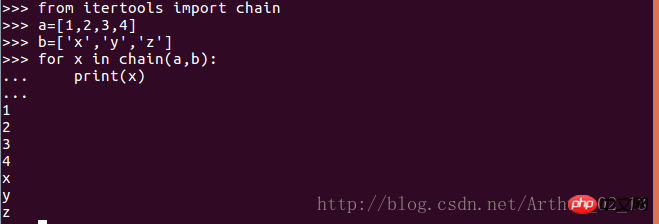
この記事では、主に Python のイテレータとジェネレータの詳細な例に関する関連情報を紹介します 必要な方は、
Python のイテレータとジェネレータの詳細な例を参照してくださいこの記事は、さまざまなアプリケーションのシナリオに焦点を当てています。そのソリューションでは、Python のイテレーターとジェネレーターに関するいくつかの関連知識が次のように要約されています。
1. イテレーターを手動で走査するアプリケーション シナリオ: 反復可能なオブジェクトを走査したい
すべての要素を走査したいが、は使用したくないfor ループ 解決策: next
()関数 を使用し、StopIteration 例外をキャッチします
def manual_iter():
with open('/etc/passwd') as f:
try:
while True:
line=next(f)
if line is None:
break
print(line,end='')
except StopIteration:
pass#test case items=[1,2,3] it=iter(items) next(it) next(it) next(it)
アプリケーション シナリオ: list 、タプル、または他の反復可能なオブジェクト
解決策: 反復操作をコンテナー内のオブジェクトにプロキシするための iter() メソッドを定義します 例:class Node:
def init(self,value):
self._value=value
self._children=[]
def repr(self):
return 'Node({!r})'.fromat(self._value)
def add_child(self,node):
self._children.append(node)
def iter(self):
#将迭代请求传递给内部的_children属性
return iter(self._children)#test case if name='main': root=Node(0) child1=Node(1) child2=Nide(2) root.add_child(child1) root.add_child(child2) for ch in root: print(ch)
3. 逆反復
アプリケーション シナリオ: シーケンスを逆に反復したい
解決策: 組み込みの reversed() 関数を使用するか、カスタム クラスに reversed() を実装します例 1a=[1,2,3,4]
for x in reversed(a):
print(x) #4 3 2 1
f=open('somefile')
for line in reversed(list(f)):
print(line,end='')
#test case
for rr in reversed(Countdown(30)):
print(rr)
for rr in Countdown(30):
print(rr)class Countdown:
def init(self,start):
self.start=start
#常规迭代
def iter(self):
n=self.start
while n > 0:
yield n
n -= 1
#反向迭代
def reversed(self):
n=1
while n <p style="text-align: left;">4. 選択的反復</p><p style="text-align: left;"><strong>アプリケーション シナリオ:反復可能なオブジェクトですが、先頭の一部の要素には興味がないのでスキップしたいです </strong></p>解決策: itertools.dropwhile() を使用します<p style="text-align: left;"></p>例 1<p style="text-align: left;"></p><pre class="brush:php;toolbar:false">with open('/etc/passwd') as f:
for line in f:
print(line,end='')from itertools import dropwhile
with open('/etc/passwd') as f:
for line in dropwhile(lambda line:line.startwith('#'),f):
print(line,end='')5 で複数のシーケンスを繰り返します。同時に
アプリケーションシナリオ: 複数のシーケンスを同時に繰り返し、毎回各シーケンスから 1 つの要素を取得したい
解決策:zip
() 関数を使用します


 6. 異なるコレクション上の要素の反復
6. 異なるコレクション上の要素の反復
アプリケーションシナリオ: 複数のオブジェクトに対して同じ操作を実行したいが、これらのオブジェクトは異なるコンテナーにあります
解決策: itertool.chain() 関数を使用します  7. ネストされたシーケンスを展開する
7. ネストされたシーケンスを展開する
アプリケーションシナリオ: 複数レベルのネストされたシーケンスを単一レベルのリストに展開したい
解決策: yield from ステートメントを使用するRecursive
Generatorfrom collections import Iterable def flatten(items,ignore_types=(str,bytes)): for x in items: if isinstance(x,Iterable) and not isinstance(x,ignore_types): yield from flatten(x) else: yield x
#test case items=[1,2,[3,4,[5,6],7],8] for x in flatten(items): print(x)
以上がPython のイテレータとジェネレータのインスタンス メソッドの詳細な説明の詳細内容です。詳細については、PHP 中国語 Web サイトの他の関連記事を参照してください。